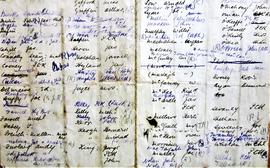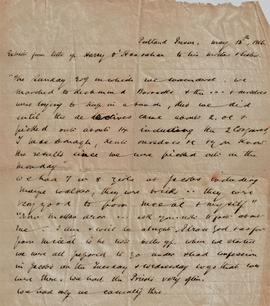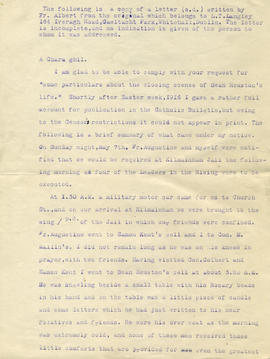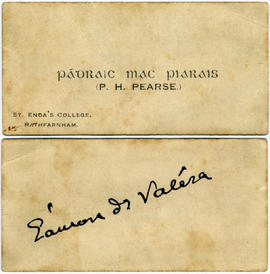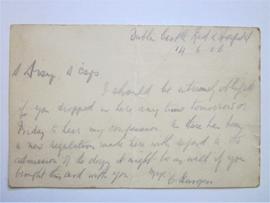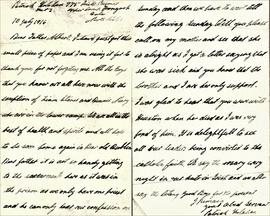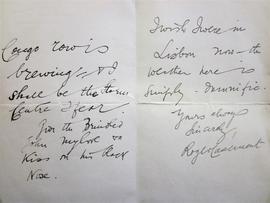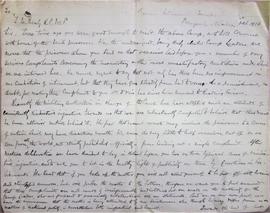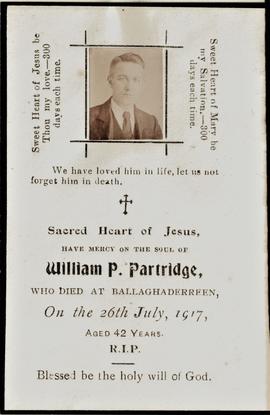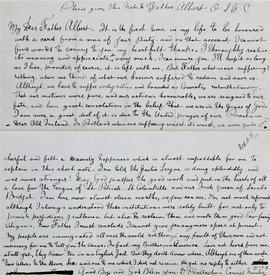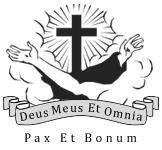Identity area
Reference code
Title
Date(s)
- c.1615-2018 (Creation)
Level of description
Extent and medium
517 linear feet comprising archival and manuscript material, published material, cartographic material, graphic visual material, moving image material, sound recordings, objects, artifacts and ephemera.
Context area
Name of creator
Administrative history
St. Francis and the First Franciscans
The Irish Capuchin Franciscans are part of story that goes all the way back to St. Francis of Assisi who was born in c.1181/2; He died in 1226. His short life has had a profound influence on the Church to this day. He remains one of the most venerated and inspirational figures in the life of the Church and in the wider world. In 1209, having heard the call of Christ from the Cross to ‘Go and Rebuild my Church!’ Francis dedicated himself and his first followers to a life of brotherhood and prayer. He led his first eleven followers to Rome to seek permission from Pope Innocent III to seek approval for their way of life. The Order of Friars Minor (Francis referred to his followers as ‘frati minori ’ or lesser brothers) is a mendicant religious order of men which includes the Capuchins. With St. Clare of Assisi, Francis also founded the second order which became known as the Poor Clares, this became an enclosed religious order for women. He later founded a third Order for men and women, both married and unmarried, which today is known as the Secular Franciscan Order. In so doing Francis founded what would grow to be a huge religious family of brothers and sisters who continue to spread the Franciscan message of peace and joy to all people. Poverty was to Francis something sacred, seeing in it an image of a poor and crucified Christ; moreover he saw the havoc wrought in the Church and in the world by avarice. Devotion to poverty for Christ’s sake is the hallmark of the Orders he founded. The short body of regulations he laid down is known as the Rule of St. Francis. The Rule prescribes the ways in which poverty is to be safeguarded, the habit to be worn, the fasts to be observed, and the guidelines to be followed in the service of the Church. St. Francis is recognised for the holiness of his life and his joy in creation by people of all spiritual traditions. He remains the inspiration and the model for Capuchin Franciscan life to this day.
The Capuchin Reform
In the early sixteenth century Matteo da Bascio, an Italian Franciscan friar, felt a call to return to a stricter observance of the Rule of St. Francis, seeking to return to the primitive way of life and penance as practiced by the founder of the Order. Matteo and his followers sought permission to live as hermits, preach as missionaries, and to wear a very simple habit after the manner of St. Francis and the early friars. With papal consent Matteo and his supporters sought to follow St. Francis’s teachings more closely. They adopted a harsh lifestyle and became known as ‘Cappucini’. The word ‘Capuchin’ is a reference to the distinctive long hood (in Italian a ‘capuce’) that these friars adopted, which became ‘Capucin’ in French, ‘Kapuziner’ in German, and ‘Capuchin’ in English. Later, constitutions were drawn up giving more definite shape to the life the friars wished to lead. The life of the friars was to be one of contemplation, austerity, simplicity and poverty emulating the ideals of St. Francis insofar as was practicable. The hermitical lifestyle was abandoned but their communities would remain small. The first constitutions also prescribed the wearing of the beard because it was ‘manly, austere, natural, and an imitation of Christ’.
By 1536, the Capuchin reform numbered some seven hundred brothers. St. Francis had directed his followers to preach among non-believers. The early Capuchins were inspired by this call. In 1574 the restrictions which had prevented the Capuchins from preaching outside of Italy were lifted and they began to expand rapidly. As the Order grew it spread across Western Europe with each community reaching into a new area. While the friars were often at the forefront of the Counter-Reformation the activities of the Capuchins were not solely confined to Europe. From an early date they undertook missions in the Americas and in Asia and in Africa. In time the Capuchins established a presence in almost every Christian country and beyond and became well-known for helping the poor and the distressed. Their name even crossed over into contemporary culture. By visual analogy, the Capuchin monkey and the Cappuccino style of coffee, are both named after the shade of brown used for their habit.
The Irish Capuchins in the Seventeenth Century
The first Irish Capuchin was Francis Lavalin Nugent. He was born in Walshestown near Mullingar, County Westmeath, in 1569. He was educated on the continent and graduated from universities in Paris and Louvain. In 1591, at the age of twenty-two, he joined the Capuchin Franciscan Order in Brussels. From the outset he made clear his determination to establish the Order in his native land. On 29 May 1608 he was given an apostolic brief from Pope Pius V authorising the Capuchins to undertake missionary work in ‘England, Scotland, Ireland and the adjoining Islands’. He recruited a number of Irish-born students for his missionary endeavours and was given the newly-built friary at Charleville, France, as a house in which members of the Order might be trained for the difficult mission in Ireland. The friary at Charleville would for many years act as a centre from which the Irish Capuchin mission was directed and nourished.
In 1615 Fr. Stephen Daly OFM Cap. became the first Capuchin friar to set foot in Ireland. Born in 1575 in Tisaran, now in the parish of Ferbane, County Offaly, Daly joined the Capuchin Order at Douai in 1606. In March 1615, he arrived in Ireland as the first Capuchin missionary just ten years after the issuing of a proclamation banishing all Catholic priests from the country. Despite the threats of persecution, Fr. Daly worked diligently, ministering principally in County Longford ‘where he so instructed (the people) and reformed (them) that the effects of his labour remained in them long after’. Other Capuchin friars soon followed. Fr. Laurence Nugent arrived in 1617, and Columbus Glynn, Robert Comyn and Edward Bath joined the mission in 1618. At first they were scattered throughout the country, but in 1624 a regular friary was founded in Dublin (where the Capuchins have remained ever since). Soon there were friaries in Slane, Limerick, Galway and Drogheda; before the end of the seventeenth century there were fourteen Capuchin houses in Ireland. By necessity, these houses were located in inconspicuous streets and lanes. From these small houses, the friars carried out their apostolic work over a wide area, secretly or in public, according to changing circumstances. Although Catholic services were generally tolerated as long as they were conducted in private, the clergy were subject to periodic spells of persecution. Many were arrested, others were deported and some were executed. Two Irish Capuchin friars, Fr. Fiacre Tobin OFM Cap. and Fr. John Baptist Dowdall OFM Cap., suffered deprivations in this period and were later feted as martyrs for the faith.
The Exiled Irish Capuchins in Europe
As the threat of religious persecution intensified in the seventeenth century, there was no possibility of establishing in Ireland the Catholic seminaries and universities required by students who aspired to train as a religious. As a result, Irish students were educated in continental universities. By necessity, for much of the seventeenth and eighteenth centuries, Irish Capuchin activity was centred in France. Friaries were established in Charleville (now Charleville-Mézières) in 1615 and in Sedan (1639). The Irish Capuchins also played an important role in the continental seminary movement by founding a college in Lille (1610) in the Low Countries. The college was governed by a rector nominated by the Irish Capuchins and it continued to educate friars for the Irish mission until its suppression in 1793. A contemporary source noted that in these French houses ‘many valiant soldiers of Christ – all of them Irish – were received into the Capuchin Order where they prosecuted their studies … and were made familiar with the French language, which they understood equally with the Irish, English and Scotch tongue. Some of those trained carried on evangelical work around Charleville and Sedan; others singly, or in batches of two, three, or four were sent to the mission in Ireland’.
In 1685, by command of King Louis XIV the Irish Capuchin communities in Charleville and Sedan were transferred to the friaries of Bar-sur-Aube and Wassy in the Champagne region. The friars educated in France and elsewhere acted as a vital link between the native Irish Catholic populace and communities of exiled Irish people abroad. Their houses also played an important role as centres of education and learning, fostering the study of the Irish language, its history and traditions. The French Revolution signaled the end for many of these Irish continental colleges as the new government ordered the suppression of all religious houses. In the early 1790s the Irish Capuchin houses in France were closed and their properties and goods were confiscated.
Fr. Theobald Mathew and the Origins of the Temperance Movement
Fr. Theobald Mathew OFM Cap. (1790-1856), an Irish Capuchin friar, inaugurated the total abstinence movement in Cork on 10 April 1838. Uttering the words: ‘Here goes in the Name of God’, he signed the register of the Cork Total Abstinence Society. The Society was established with the aim of encouraging people to make one enduring act of will which would keep them sober for life. This act of will was enshrined in the pledge to abstain from the taking of intoxicating liquor. The pledge itself was a standard one with occasional slight variations. It simply stated, ‘I promise to abstain from all intoxicating drinks, except used medicinally, and by the order of a medical man, and to discountenance the cause and practice of intemperance’. In addition to taking a verbal pledge and entering their names on a membership role, each Society member received certificates, medals, printed advice and a set of the Society’s rules. The medals were particularly important as they served as reminder of the pledge, and also as miniature temperance catechisms for the many illiterate people who had taken the pledge. Most of the medals were made of pewter, although some silver and gold medals were made for particularly distinguished members.
The Decline of the Temperance Movement
Despite the personal adulation accorded to him both at home and abroad, it soon became clear that Fr. Mathew’s movement had reached its zenith. From the late 1840s the movement began to decline almost as dramatically as it had risen. Mathew’s health started to fail and debts began to accumulate, making it increasingly difficult to continue the temperance campaign. The onset of the Famine, brought about by the failure of the potato crop, dealt a grievous blow to his movement; thousands of Mathew’s followers died or emigrated in those years. Many of those who remained in Ireland had to contend with more pressing concerns than the maintenance of their pledge. In late 1853, despite declining health, Mathew ventured to Limerick where he administered the pledge in what was his last appearance at a public meeting. In October 1854, on medical advice, he travelled to Madeira but his health continued to deteriorate. In the absence of its charismatic leader the temperance movement continued to weaken. Mathew suffered a serious stroke in late 1856 and he died in Cobh, County Cork, on 8 December 1856. He was buried in St. Joseph’s Cemetery, Cork, which he had himself established twenty-six years earlier.
Rebuilding the Irish Capuchin Province, 1860-1885
Following the death of Fr. Theobald Mathew OFM Cap. in 1856 the Irish Capuchins experienced a sharp decline in their fortunes. The few friars living in Ireland – only about a dozen in total – struggled to exert a distinct identity. Community life, so vital to the Franciscan tradition, was non-existent. The absence of a novitiate to train young men aspiring to the join the Order represented a serious impediment. A mission to Ireland in 1857 undertaken by the Capuchin leadership in Rome attempted to enforce a stricter observance of Rule and Constitutions of the Order. Brothers began to publically wear the religious habit and started to live in communities. Foreign Capuchins were also sent to Ireland to provide assistance. In 1861, Fr. Lawrence Gallerani OFM Cap., a friar from Bologna, Italy, arrived in Dublin and was appointed Commissary General. Another Italian, Fr. Cherubini Mazzini OFM Cap., settled in Cork at about the same time. These foreign friars adapted to their new surroundings and quickly gained the esteem and affection of the local populace. Despite these developments, there seemed little prospect of an increase in the number of Capuchins in the country and the decision was made in 1864 to amalgamate the English and Irish jurisdictions of the Order into a single Anglo-Irish custody.
There was little doubt that the Irish friars lamented the loss of their independent status. Many feared a loss of their distinct heritage. Moves were therefore made to restore the canonical status of the Irish Province. Vital to this process was the establishment in 1875 of a novitiate in Kilkenny. The founding by Fr. Seraphim Van Damme OFM Cap., a Belgium friar, of a Seraphic School at Rochestown, County Cork, in 1886 marked another important step in fostering vocations. Having now secured the means of educating potential aspirants to the Order, the prospects for the Irish Capuchins seemed much brighter. The hard work of the preceding years culminated in the restoration (by papal decree) of the Irish Capuchin Province on 21 January 1885. Fr. Seraphim was appointed provincial minster of the Irish Capuchins. Two years later, Fr. Paul Neary OFM Cap. of Kilkenny was appointed as the first native-born superior of the newly-restored Irish Province.
Irish Capuchin Chaplains and the First World War
After the outbreak of war in August 1914, large numbers of Irish priests applied to work as army chaplains in order to provide spiritual comfort to Catholic troops serving in the British armed forces. Four Irish-born Capuchin friars served in the First World War. They served on the battlefields of France, Egypt, Palestine and Salonika. They shared the day-to-day struggles of soldiers trying to cope with the appalling realities of industrial warfare and its aftermath. It is estimated that 200,000 Irishmen and women served during the war.
Fr. Ignatius Collins OFM Cap.
Ignatius Collins was born in Cork in 1885 and entered the Capuchin Order in 1910. In May 1915, he responded to the call of Cardinal Francis Bourne, Archbishop of Westminster, seeking priests to act as army chaplains. He joined the newly-formed 23rd Division and was sent to France in August 1915. He acted as chaplain with the 69th Field Ambulance Corps. During the First World War his division served on the Western Front participating in many major offensives including the Battles of the Somme and Messines. In October 1917 the Division was transferred to the Italian Front. In January 1918 Fr. Ignatius was awarded the Military Cross in recognition of ‘exemplary gallantry during active operations against the enemy’. He was also promoted to the rank of Major. After the war he returned to Ireland and in 1922 was elected Guardian of the Capuchin Friary in Kilkenny. In 1943 he was transferred to Dublin where he died on 21 October 1961.
Fr. John Butler OFM Cap.
John Butler was born in Sheestown, County Kilkenny in 1873. He joined the Capuchins in 1890 and was ordained in 1899. In April 1916 he was appointed a chaplain in the British Army with the rank of Captain. He served for a short time with the home garrisons in Canterbury and in Blackpool. He was later sent to the Middle East and Palestine as part of the Egyptian Expeditionary Force (EEF) who fought the Ottoman Turks for control of this strategically important region. He was present at the Battle of Gaza (March 1917), and the capture of Jerusalem (December 1917), and later acted as chaplain in a casualty clearing station in Damascus. Fr. John returned to Ireland in 1919 and spent the following eleven years in the Capuchin Friary on Church Street, Dublin. In 1930 he moved to Cork and was attached to the community at Holy Trinity Friary. He died in Cork on 3 October 1950
Fr. Dominic O’Connor OFM Cap.
Dominic O’Connor was born in County Cork in 1883. He joined the Capuchin Order in October 1899 and was ordained in March 1906. In response to a call from Cardinal Michael Logue, Archbishop of Armagh, Fr. Dominic volunteered for army chaplaincy work in 1915. After spending two months with a Scottish brigade in England, he transferred to the 21st Stationary Hospital Unit bound for Salonika, Greece. He served with the 10th (Irish) Division as part of the Mediterranean Expeditionary Force (MEF). He was chaplain to the 6th Munster Fusiliers and later ministered to the 6th and 7th Dublin Fusiliers mainly in Macedonia. After approximately two years of service, Fr. Dominic resigned his post in 1917, returned to Ireland and was appointed to the Capuchin community at Holy Trinity Friary, Cork. Fr. Dominic soon attained notoriety in nationalist circles and was appointed chaplain to the Cork Brigade of IRA Volunteers led by Tomás MacCurtain. Fr. Dominic died in Oregon, United States, on 17 October 1935.
Fr. Laurence O’Dea OFM Cap.
Laurence O’Dea was born in County Kilkenny in 1851. He joined the Capuchin Order in England in 1868. He was ordained a priest in May 1874. At the outbreak of the First World War, he put forward his name for military chaplaincy. His offer was accepted and he was made chaplain to a large convalescent camp established at Eastbourne on the English Coast for wounded and shell-shocked soldiers of the conflict. At its peak, the Eastbourne camp accommodated 3,500 injured soldiers. Over burdened by this difficulty ministry, Fr. Laurence died in the Military Hospital at Palace Green in London on 4 November 1917. He was buried in the graveyard of the Friary Church of St Francis in Crawley, Sussex.
The Capuchins and the 1916 Rising
The events of the 1916 Rising has resulted in the Capuchins becoming very prominently associated in the public mind with the Irish revolution. The Capuchins of Church Street found themselves in the thick of the fighting when the Rising broke out on Easter Monday (24 April). On that day the friars heard the first shots of the Rising and witnessed barricades being erected on the streets around them. Following the occupation of the Four Courts by Commandant Edward Daly, Church Street became a centre of Irish Volunteer activity. A first aid post was established in the Capuchin-run Father Mathew Hall and Volunteers were posted on Church Street Bridge. Jameson’s Distillery and the adjoining houses were also occupied. The area would see some of the bitterest engagements of the Rising as British forces repeatedly attacked Volunteer positions around Church Street. The friars were in constant attendance in the Hall, providing consolations to the combatants, conveying the wounded to Richmond Hospital and hearing the confessions of the Volunteers in the houses which they occupied. As the week wore on army reinforcements began encircling the Volunteers in the Four Courts. Consequently, the situation in Father Mathew Hall became ever more desperate. Those more seriously injured were moved to Richmond Hospital but Cumann na mBan members continued to care for casualties in Father Mathew Hall. By Saturday, 29 April, the British military had retaken North King Street and it seemed very likely that the Hall would be shelled. Under the protection of a white flag, Fr. Augustine Hayden OFM Cap. and Fr. Aloysius Travers OFM Cap. approached the British barricades to begin negotiations. Fr. Augustine explained that the Hall was being used as a hospital and that Capuchin priests had been placed in charge of the wounded.
On Saturday, Pádraig Pearse formally surrendered the General Post Office garrison. Fr. Columbus Murphy OFM Cap. (accompanied by Elizabeth Farrell, a Cumann na mBan nurse) later interviewed Edward Daly at the Four Courts and convinced him that Pearse’s surrender was genuine. The Four Courts garrison laid down their arms and marched along the quay via Capel Street to the Rotunda Hospital. Meanwhile, a truce was agreed in the Church Street area on Sunday, 30 April. Fr. Aloysius and Fr. Augustine were later granted permission to visit Pearse in Arbour Hill Prison and James Connolly in Dublin Castle Hospital. The rebel leaders agreed that the Capuchin friars should convey the surrender order to the last garrisons still holding out in the city. Subsequently, Fr. Augustine and Fr. Aloysius mediated negotiations between the British authorities and Thomas MacDonagh (Jacob’s Factory) and Éamonn Ceannt (South Dublin Union) for the peaceful capitulation of the men and women under their command.
Kilmainham Jail Executions
On Monday, 1 May, a call was made to the Church Street Friary conveying the message that James Connolly wanted to speak with Fr. Aloysius. Many of the Capuchin friars were subsequently given permits to travel freely through the city and visit rebel prisoners at their places of detention. After the court martials of the Rising leaders it became apparent that the Capuchins would be required to minister to these men before their executions. On Tuesday, 2 May a note was delivered by the British military to the friars requesting them to visit Pádraig Pearse and the other condemned prisoners. Fr. Aloysius went to Kilmainham to hear the final confessions of Pearse and Thomas MacDonagh. The Capuchin priest was forced to leave the prison before the executions of the two men took place – an action which Fr. Aloysius vehemently protested. ‘In every civilised country’, he argued, ‘the clergy were permitted to remain with the prisoners and administer the last rites of the Church’. As a result of this plea, a Capuchin friar was allowed to remain at a prisoner’s side until the end. Thomas Clarke was later attended to by Fr. Columbus Murphy OFM Cap.
As the executions continued, the Church Street friars were repeatedly called upon to minister to the rebel leaders in Kilmainham. On Thursday, 4 May, Fr. Augustine recollected how he ‘called Fathers Albert [Bibby], Columbus and Sebastian [O’Brien] and we started for Kilmainham where the Governor told us that four were to be executed – Edward Daly, Michael O’Hanrahan, Joseph Mary Plunkett and Willie Pearse. The Governor told us that there was not much time, but he had got a slight postponement of the fixed hour so as to give us an opportunity of attending the men. Father Columbus, having met him before at the surrender, naturally went to the first [Daly], Father Albert to the second [O’Hanrahan], Father Sebastian to the third [Plunkett], and I to Willie Pearse whose hands were already tied behind his back’.
Fr. Augustine wrote a moving account of Con Colbert’s death on 8 May, explaining how ‘his heart was near to God and to his friends’ in his last moments. Fr. Albert Bibby OFM Cap., who ministered to Seán Heuston, left an account of the closing scenes of his life: ‘A soldier directed Seán and myself to a corner of the yard, a short distance from the outer wall of the prison. Here there was a box (seemingly a soap box) and Seán was told to sit down upon it. He was perfectly calm, and said with me for the last time: “My Jesus, mercy”. I scarcely had moved away a few yards when a volley went off … I rushed over to anoint him: his whole face seemed transformed and lit up with a grandeur and brightness that I had never before noticed’. Not only did the Capuchins attend the executions but they also relayed last messages to relations. Fr. Aloysius also made contact with John Dillon, a nationalist MP, in an attempt to bring a halt to the executions. He explained to Dillon how ‘the feeling among the working classes in the city was becoming extremely bitter over these executions and this feeling is strong even among those who had no sympathy whatever … with the Rising’.
On 12 May, a military car called to the Church Street Friary for what would be the final time. Fr. Aloysius travelled to Dublin Castle Hospital where he heard the last confession of James Connolly. He then accompanied Connolly who was taken on stretcher to an ambulance which took him to Kilmainham. The Capuchin friar stood behind the firing party as Connolly was placed on a chair and shot. ‘It was a scene I should not ask to witness again’, Fr. Aloysius later remarked, ‘I had got to know Connolly – to wonder at his strength of character … [and] now I had to say goodbye. All I could do was to return to Church Street and to offer the Holy Sacrifice for his soul. May he rest in peace’.
The Capuchins and the later Revolutionary Period, 1917-1923
The executions of the 1916 Rising leaders resulted in a deepening of Irish nationalist disaffection with British rule in Ireland. Over 2,500 people were arrested and detained in Britain in the aftermath of the insurrection. Remembering the role played by the Capuchins in ministering to the rebels during Easter Week, many of the prisoners continued to communicate with the friars to express their gratitude for their dedicated service to the republican cause. One such prisoner, Henry O’Hanrahan, a brother of Michael, the executed rebel leader, who himself had fought in the Rising wrote to Fr. Albert Bibby OFM Cap. claiming ‘it will be a while indeed till we here … or in Ireland forget what we owe to “Church Street” … on a very memorable Easter Sunday’.
In many respects, the British response to the Rising was determined by wartime necessity. The threat of the imposition of military conscription in Ireland in 1918 had the effect however of sharpening nationalist resistance and was instrumental in popularising republican goals. Fr. Thomas Dowling OFM Cap., a Capuchin friar in Cork, was prominent in the campaign to resist conscription. The Sinn Féin Lord Mayor of Cork, Tomás MacCurtain appointed Fr. Dominic O’Connor OFM Cap. (recently returned from chaplaincy work in the British Army) as brigade chaplain to the local Volunteers. The Capuchin priest arranged for the celebration of masses and made general provision for the spiritual needs of the Volunteers. After the outbreak of the War of Independence, Fr. Dominic adapted his pastoral ministry to meet the needs of the irregular warfare which defined the conflict. As MacCurtain’s chaplain, he was also the first to arrive at the family home on the morning the Lord Mayor was shot. Later, as chaplain to MacCurtain’s successor as Mayor, Terence MacSwiney, Fr. Dominic remained with him to provide spiritual comfort during his hunger strike in Brixton Prison. He was also a prominent mourner at MacSwiney’s funeral in October 1920 which was marked by an impressive demonstration of nationalist sentiment. Fr. Dominic was later arrested following a raid on the Church Street Friary in Dublin in January 1921. He was court martialled and sentenced to five years’ imprisonment but was released the following year under the terms of a general amnesty following the signing of the Anglo-Irish Treaty.
Other friars played a significant role in the nationalist struggle. Fr. Albert Bibby OFM Cap. ministered to the eighteen year-old Kevin Barry in Mountjoy Jail prior to his execution (1 November 1920) for his role in an attack on the military on Church Street. Another friar who had come to public prominence for his role in the 1916 Rising, Fr. Augustine Hayden OFM Cap., actively campaigned on behalf of republican prisoners throughout the War of Independence.
The Capuchins and the Irish Civil War
The Anglo-Irish Treaty, signed on 6 December 1921, caused deep divisions in the republican movement. It was narrowly ratified by Dáil Éireann in January 1922 but an Anti-Treaty group led by Éamon de Valera subsequently withdrew from the parliament in protest. The IRA was similarly divided and opponents of the Treaty commanded by Rory O’Connor occupied the Four Courts in Dublin in April 1922. Despite frantic efforts at reconciliation, the building was attacked by the forces of the newly-established Provisional Government (which later became the Free State administration) on 28 June marking the opening shots of the Civil War.
Once again the Capuchins of Church Street became involved. Priests offered spiritual assistance to the republican garrison occupying the Four Courts which was located only a couple of hundred meters from the Friary. Both Fr. Albert and Fr. Dominic, whose sympathies rested with the Anti-Treaty side, attended to the men as they came under attack. Dominic remained in the Four Courts whilst Albert sought out medical assistance for the wounded. As the fighting intensified both Capuchin friars urged the republicans to surrender in order to minimize casualties. Following the capitulation of the Four Courts garrison the two friars proceeded to minister to Cathal Brugha and other IRA men occupying the Hamman Hotel on O’Connell Street. The surrender of the Four Courts by the Anti-Treaty militants was followed by the loss of other key buildings in Dublin. Thereafter, the republicans were forced to adopt an irregular form of warfare against the superior and better-equipped Free State Army. After the death of Liam Lynch in April 1923, de Valera called for a ceasefire bringing a conclusion to the Civil War.
Following the end of hostilities, a decision was made by the Provincial Minister of the Capuchin Order in Ireland to have both Fr. Albert and Fr. Dominic transferred to the missions in America. In June 1924 Albert was sent to the Irish Capuchin mission at Santa Inés, California. He was appointed pastor and immediately set about restoring the parish structures of the old Franciscan mission station. His health soon deteriorated however and he was admitted to Santa Barbara Hospital. He died there on 14 February 1925. Dominic went to the Province’s mission in Bend, Oregon, on the American Pacific Coast. For the remainder of his life, he performed the ministries associated with the missionary apostolate of a Capuchin friar. He was appointed a rector of St. Francis de Sales Cathedral in Baker City, Oregon. In August 1935 he sustained serious injuries in a car accident from which he never fully recovered. He died on 17 October 1935. Following a long campaign by the Old IRA Fr. Dominic’s remains (along with those of Fr. Albert) were repatriated to Ireland. They were buried in the cemetery of Rochestown Capuchin Friary, County Cork, on 14 June 1958.
The Capuchins and the Promotion of Irish Culture
It was clear that the cultural resurgence associated with organisations such as the GAA and Conradh na Gaeilge (Gaelic League) deeply influenced the men who were drawn to Capuchin religious life. Many of the friars were fluent Irish speakers. Both Fr. Augustine Hayden OFM Cap. and Fr. Albert Bibby OFM Cap. were enthusiastic members of the Gaelic League, regularly preaching in the native language in Gaeltacht areas. The Feis an t-Athair Maitiú (Father Mathew Feis) was established in 1909 by Fr. Aloysius Travers OFM Cap. who saw the need for a festival to encourage people interested in preserving Irish language and culture. Concurrently, Fr. Aloysius also founded 'The Father Mathew Record', a monthly magazine which sought to promote the ideals of temperance, support Irish manufactures and revitalize interest in native culture. The Feis strongly promoted Gaelic revivalist activities such as storytelling and performances of native song and dance. Early adjudicators at the Feis included Sinéad Ní Fhlannagáin (wife of Éamon de Valera), John Joseph O’Kelly (known as Sceilg), president of the Gaelic League, and Eoin MacNeill, founder of the Irish Volunteers. Later, the Feis programmes expanded to include competitions for instrumental music, and drama and poetry recitals in both Irish and English. In 1927 Feis Maitiú Corcaigh was established by Fr. Michael O’Shea OFM Cap. (1892-1958) as a platform for the performing arts in Cork. Many prominent figures in the arts received their first introductions to the stage at the Feis Maitiú including Brenda Fricker, Gay Byrne, and the pianist John O’Connor. Father Mathew Hall on Church Street continued to act as a focal point for the promotion of amateur theatre and music until the late 1990s when the costs associated with organising the Feis competition became prohibitive and the Hall was closed as a public amenity. Both the Cork and Dublin festivals continue to encourage and support young music and drama students through its annual competitions.
The Capuchins and Gaelic Games
Cumann Lúthchleas Gael (the Gaelic Athletic Association) was founded in 1884 with the aim of promoting the traditional Irish sports of hurling, camogie, Gaelic football and handball. It immediately attracted the support of many Irish Capuchins. The most notable among these was Fr. Edwin Fitzgibbon OFM Cap. He was born in 1874 to a large Irish-speaking family from Ballynona, County Cork. He was educated in the hurling stronghold of Dungourney, home to his cousin Jamesy Kelleher (1878-1943), one of the most famous hurlers of his age. Fr. Edwin was appointed Rector of Rochestown College, County Cork, in 1906 where he became a passionate supporter of the school’s Gaelic teams. In December 1908, Queen’s College, Cork became one of the constituent colleges of the new National University of Ireland. Fr. Edwin was one of the first appointees to the new college becoming Professor of Philosophy in 1909. In 1912 he was elected President of the UCC hurling club. Almost immediately, he donated his annual salary (reckoned to be about £80) for a trophy to be contested by the hurling teams of various colleges within the NUI. The Fitzgibbon Cup was the last national Gaelic trophy to be named after a living person, and the donor remained a regular fixture at the presentation ceremonies for the next twenty-five years. The Cup remains the preeminent inter-colleges hurling competition. In later years, friars such as Fr. Micheál Ó Sé OFM Cap. (1892-1958), Fr. Nessan Shaw OFM Cap. (1915-1997) and Fr. Dominic Atkinson OFM Cap. (1918-1997) were to the fore in promoting Gaelic games particularly in County Cork.
'The Capuchin Annual'
'The Capuchin Annual' was published from 1930 until 1977. Although its readership was predominately Irish, its circulation was international as it was frequently sent to Irish emigrants particularly in the United States and in Australia. It was a journal unique in Irish publishing containing many literary, historical, topographical, theological, biographical, artistic and cultural articles. Many Irish writers, artists and educators who later rose to prominence such as Benedict Kiely, Francis MacManus and Augustine Martin received their first opportunities to publish with the 'Annual'. It maintained a very high quality of contributions by leading politicians, writers and artists including: Pádraig Ó Siochfhradha, Pearse Hutchinson, Daniel Corkery, Alice Curtayne, Aodh de Blácam, Jack B. Yeats, Richard J. King, Thomas MacGreevey, Brinsley MacNamara, Richard Mulcahy, Leon Ó Broin, Cathal O’Byrne, Brian O’Higgins, Margaret Pearse, Maura Scannell and Francis Stuart. The 1966 edition of the 'Annual' is particularly well-known as it contained detailed articles, profusely illustrated, on the Easter Rising.
The publication only ever had two editors, Fr. Senan Moynihan OFM Cap. and Fr. Henry Anglin OFM Cap., under whom a strongly nationalistic theme was reflected in many of the articles. The distinctive cover illustration of St Francis and the wolf was designed by Seán O’Sullivan RHA (1906-1964). Colm Ó Lochlainn printed the first three issues of the Annual. John English & Co. of Wexford assumed publication from 1934 until 1957, and from 1958 until the final issue in 1977 it was printed by Dollard Printinghouse. The 'Annual' was one of the most widely-read Irish literary publications of the twentieth century and it had a print run in the region of 20,000 copies per issue. It ceased publication in 1977 as a result of increasing printing costs.
The Capuchins and University Education
It was clear that those who aspired to join the Capuchins needed to be suitably educated to respond to a variety of pastoral needs. A thorough training in scripture and philosophy was required. Following the restoration of the Irish Capuchin Province in 1885 many Capuchin students began taking university courses. The Irish Universities Act (1908) formed the National University of Ireland consisting of three constituent colleges in Dublin, Cork and Galway. The friars responded positively to this development and played an active role in fostering the growth of the study of humanities in University College Cork. Fr. Edwin Fitzgibbon OFM Cap. (1874-1938) was appointed Professor of Philosophy in 1909. Fr. Cyril O’Sullivan OFM Cap. (1887-1921) became a lecturer in the same department in 1916 and ably assisted Fr. Edwin in establishing the Philosophy Faculty. In 1917 Victoria Lodge, situated a short distance from UCC, was purchased. Re-named St. Bonaventure’s Hospice, it became a house for Capuchin students attending the University.
The quality of the work done in the Philosophy Department by teachers and students alike was reflected in the many first class distinctions obtained. Following Fr. Edwin’s death in 1938, his role as head of the Philosophy Department was assumed by another Cork-born friar, Fr. James O’Mahony OFM Cap. (1897-1962). An outstanding scholar, Fr. James published over thirty philosophical and theological tracts and was an influential leader of the Irish Capuchins serving as Provincial Minister for twelve years. In 1965, Fr. Brendan O’Mahony OFM Cap., a nephew of Fr. James, was appointed Professor of Philosophy, a position he would hold for thirty-five years. He also served as Dean of the Arts Faculty and Vice-President of UCC. Other Capuchins also left their scholarly mark. Fr. Paschal Larkin OFM Cap. (1894-1976) pioneered the study of Irish economic history. Fr. Peter Dempsey OFM Cap. (1914-2004) was a full-time member of staff in UCC for thirty-one years and founded the Chair of Applied Psychology, a position he held until his retirement in 1982. Inspiring teachers and acclaimed academics, these Capuchins left an indelible mark, bringing their chosen subjects to a position of eminence not alone in UCC but in Ireland.
The Missionary Contribution / Nineteenth-Century Pioneers
From the middle of the nineteenth century the Irish Capuchins manifested a missionary zeal which took them from home to the farthest corners of the globe. By 1900 Irish friars were ministering in India, Australia and Arabia. Men like Fr. Joseph Harkins OFM Cap. Fr. Patrick Knaresboro OFM Cap. and Fr. Salvator Corrigan OFM Cap. volunteered for difficult missionary work in India. Other friars worked among emigrant communities in Australia. Fr. Albert Mitchell OFM Cap. and Fr. Benedict Mary McCabe OFM Cap. ministered for many years in the city of Armidale in New South Wales, Australia. Fr. Jeremiah Joseph O’Reily OFM Cap., a Cork-born friar, was the first resident Catholic priest in Wellington, New Zealand.
The Western American Mission
In 1910 the Irish Capuchins received a request for missionaries from Charles Joseph O’Reilly, the Bishop of the Diocese of Baker in Oregon on America’s Pacific coast. The Irish friars responded positively to this request and dispatched Fr. Luke Sheehan OFM Cap. and Fr. Casimir Butler OFM Cap. to develop the mission. Churches were built in Hermiston, Bend and Roseburg and in other locations in Oregon. The early Capuchin missionaries spent most of their time serving the pastoral needs of newly-arrived emigrants scattered across the American west. They also ministered to Native Americans who had been forced to live on isolated reservations. The presence of the friars in the far west meant that a Capuchin foundation in the Eastern United States was desirable primarily as a base for training missionaries. However, attempts to establish communities in Abbottstown, Pennsylvania (1911) and at Lincoln, Nebraska (1920) were ultimately unsuccessful. In the meantime the Irish friars were expanding their mission in the west. In 1920 they moved to California. Friaries were established in Mendocino City, Fort Bragg, Willitis, Elk, Ukiah, Watts (Los Angeles) in California. In each of these locations churches and schools were built serving as centres for parochial ministry and missionary work. In 1924 the friars took charge of Santa Inés, one of the historic Franciscan missions in California. A presence in the San Francisco Bay locality was secured with the founding in 1927 of a friary in Burlingame. In 1979, after almost seventy years of pioneering work, the Capuchin friars of Western America were strong enough to establish their own independent province. The legacy of the Irish missionary friars is demonstrated by their role in founding a vibrant ministry which now serves Asian, Hispanic, Native and African Americans in one of the most racially diverse regions of the United States.
South Africa
In 1927 the Vicar Apostolic of Cape Province in South Africa, the Most Rev. Bernard O’Reilly, invited the Irish Capuchins to open a mission. The friars responded positively to this request and in 1929 Fr. Casimir Butler OFM Cap., Fr. Alban Cullen OFM Cap., and Fr. Declan McFadden OFM Cap. began missionary work in the Cape Flats on the outskirts of Cape Town. From the outset the friars ministered among the marginalized black and coloured populations of the area. Two mission stations, Athlone and Parrow, were initially assigned to the Capuchins. In 1935 the two parishes at Athlone and Parow expanded to incorporate ministries at other locations including Langa, the Welcome Estate and Matroosfontein. In spite of the violent political unrest provoked by the system of racial discrimination known as apartheid the Irish friars continued to labour among the poorest in society. Education was a key element of missionary work within the Capuchin parishes and schools were established by the Christian Brothers and the Holy Cross Sisters. In the 1980s the mission in South Africa was raised to the status of a Vice-Province of the Irish Capuchins. Irish friars continue to work in a variety of religious and social ministries in the country.
Zambia
In 1930 another field of missionary activity was offered to the Irish Capuchins. They were invited into a vast area of 168,000 km2, comprising the Livingstone district and Barotseland, the western province of what was then called Northern Rhodesia (now the independent Republic of Zambia). It is a territory drained by the upper reaches of the River Zambezi and includes the world-famous Victoria Falls. The Irish Capuchins arrived in Livingstone in 1931. The friars had taken on what was regarded as one of the most difficult missions in southern and central Africa. Until 1938 there were no roads, and the friars travelled on foot or in canoes and barges on the Zambezi. Lions, leopards and crocodiles posed some threat but more harmful to health were the smaller creatures such as tsetse flies and mosquitoes which carried a significant risk of malaria and other diseases. The friars also had to acquire knowledge of the native language of Lozi. The first mission station was founded in Loanja in 1932. Others soon followed including Sichili (1936), Lukulu (1935), Mankoya (1938), Sihole (1943), Katima Mulilo (1944), Malengwa (1947), Sioma (1953) and Senanga (1967). St. Theresa’s, later the Cathedral Church of the Diocese of Livingstone, was also built by the friars. Hospitals, clinics and schools were established at the mission stations and they served as centres of pastoral care, education and general medical welfare.
Over one hundred Irish Capuchins have ministered in Zambia since the start of missionary work in the country. Working alongside members of other religious congregations and lay teachers, nurses and doctors, they have had an immeasurable impact on the lives of thousands of impoverished Zambians. In 1992 the Zambian mission officially became a Vice-Province of the Irish Capuchins. In 2012 Fr. Thomas Zulu OFM Cap. became the first native-born leader of the friars in Zambia. Irish Capuchins are still working and ministering in Zambia continuing an unbroken eighty-year record of service on the African continent.
New Zealand
The Irish Capuchins arrived in New Zealand in 1958 following an invitation from the Most Rev. Peter McKeefry, Archbishop of Wellington. Fr. Agathangelus Herlihy OFM Cap., who had previously ministered in Africa, was accompanied by Fr. Matthius Murphy OFM Cap. (1930-2008). Their first foundation was in Kelburn, a suburb of Wellington. The small group of Capuchins worked diligently to expand their ministry. In 1976 the friars established a new community in the parish of Henderson in Auckland. Further growth was ensured by the establishment of a postulancy programme for those interested in joining the Capuchins and experiencing life as a friar. Among many ministries in New Zealand, the Capuchins presently have pastoral care of three parishes, St. Patrick Parish, Kilbirnie in Wellington, and Holy Cross Parish, Henderson, and St. Mary’s Parish, Avondale, in Auckland.
South Korea
Irish Capuchin missionary activity in South Korea began in July 1986 with the arrival of four friars. Br. Pat Kelleher OFM Cap. led the mission and was appointed guardian of the first Korean community. Although Catholics formed only a small percentage of the population, the Capuchin ministry soon took roots. In 1993 the first Korean postulants were received and two years later a novitiate was established in Seoul. In 2005 the Capuchin presence was raised to the status of a semi-autonomous custody of the Irish Capuchins. At present, there are sixteen Capuchin friars living in three different fraternities in South Korea.
Principal Irish Capuchin Foundations
St. Mary of the Angels, Church Street, Dublin
The Capuchins first arrived in Dublin in 1615 but it was not until 1624 that the first friary was established on Bridge Street. They came to Church Street in about 1690 and shortly afterwards opened a Mass house on the site of the present-day Church. A new church was built in 1796. The existing Church of St. Mary of the Angels dates from 1881. The architect was James J. McCarthy (1817-1882). The altar and reredos was designed by James Pearse, the father of Pádraig and Willie Pearse who were executed following the 1916 Rising. It was friars from the Church Street community who ministered to the condemned rebel leaders after the Rising and administered the last rites. Today the friars serve the local community through parish work and through the Capuchin Day Centre. The Capuchin Mission Office, which supports the work of Irish friars ministering overseas, is also located in Church Street. St. Mary of the Angels is not a parish church but the friars do have responsibility for nearby St. Michan’s, Halston Street, one of the oldest parishes in Dublin.
Church of the Most Holy Trinity, Cork
The Capuchins arrived in Cork in about 1637. By the early eighteenth century they had established a permanent apostolate in the South Parish and by 1741 they had built a small friary on Blackamoor Lane situated just behind O’Sullivan’s Quay. During the first half of the nineteenth century Cork underwent a rapid expansion in population. It soon became apparent that the friary on Blackamoor Lane was not sufficient to meet the demands of a growing congregation. In 1825 Fr. Theobald Mathew OFM Cap. decided to build a larger church in a more convenient location. A location on what was then called Charlotte Quay (now Father Mathew Quay) below Parliament Bridge was chosen. The architect of the new church was George Pain (1793-1838). The building works encountered numerous setbacks and it took many years to complete Holy Trinity. The interior was completed ten years after Pain’s death by William Atkins. The distinctive gothic portico and spire were not constructed until 1890. The interior has very fine stained glass windows by the famed artist, Harry Clarke (1889-1931). The adjoining friary was built by Robert Walker (c. 1835-1910) in 1884. Holy Trinity Church is an outstanding example of Gothic Revival architecture and its soaring spire remains a distinctive landmark on the Cork skyline.
Church of St. Francis, Kilkenny
The Capuchins first arrived in Kilkenny in 1643. On their arrival they stayed in a rented house near St. Caince’s Cathedral. The Bishop of Ossory, Dr David Rothe, subsequently gave them charge of one of the chapels in the cathedral. The Capuchins withdrew from Kilkenny in the mid-eighteenth century but a community was reinstated there in the 1770s. The Capuchins established a friary in an alms house known as the ‘Poor House Chapel’ on Walkin Street (subsequently called Friary Street). The site of the ‘Poor House’ is covered by a wing of the friary which runs at right angles along Walkin Street towards Pennyfeather Lane. In 1848 the present Church of St. Francis was built on the site. The friars provide missions and retreats to the people of Kilkenny city and county. They also undertake chaplaincy work in St. Luke’s Hospital. In 2014 the Capuchins began the Friary Food Project which provides food parcels to the poor and homeless of Kilkenny.
Rochestown, County Cork
The Capuchins opened a friary at Rochestown, situated about five miles from Cork city, in 1873. A Seraphic School was established in 1884. This school originally operated along the lines of a novitiate for young students who aspired to join the Capuchin Order. In 1887 the school was transferred from Kilkenny to Rochestown. The present-day St. Francis College in Rochestown is a voluntary secondary school for boys. The College remains under the trusteeship of the Capuchin Order and it currently has an enrolment of over six hundred students.
Ard Mhuire Friary, County Donegal
The Capuchins took possession of Ards House and demesne (formerly the residence of the Stewart-Bam family) near Cresslough in County Donegal in 1930. The friars changed the name of the old house to Ard Mhuire which became a theological seminary. A fire in December 1944 caused considerable damage to the old house and the decision was made in the mid-1950s to demolish the mansion and build a new friary and church. The new Ard Mhuire building was formally opened on 13 November 1966. The friary overlooks the shores of Sheephaven Bay and now offers retreats, conferences, seminars, and periods of rest, reflection, prayer and holidays.
Other Irish Capuchin Foundations
New foundations at Raheny (1946) and in Carlow (1978) facilitated the growth of new ministries and apostolates for the friars. In 1974 the Capuchins formally took over their first parish at Priorswood in North County Dublin.
Repository
Archival history
Immediate source of acquisition or transfer
Content and structure area
Scope and content
Appraisal, destruction and scheduling
Accruals
System of arrangement
Conditions of access and use area
Conditions governing access
Access is open to bona fide researchers. Records containing personal information are subject to access restrictions.
Conditions governing reproduction
Language of material
Script of material
Language and script notes
Physical characteristics and technical requirements
Finding aids
Allied materials area
Existence and location of originals
Existence and location of copies
Related units of description
Notes area
Note
The Capuchin Franciscans are an order of friars within the Catholic Church, among the chief offshoots of the Observant Franciscans (Order of Friars Minor) founded by St. Francis of Assisi in 1209. The Capuchins have used several postnominal abbreviations during their existence. In Latin, the Order is officially referred to as the 'Ordo Fratrum Minorum Capuccinorum' (Order of Friars Minor Capuchin) usually abbreviated to OFM Cap. Up until about 1930, the postnominal abbreviation of OSFC (Latin: 'Ordinis Santi Francisci Capuccinorum') was widely used. The catalogues reflect this change and utilize the older postnominal abbreviation of OSFC to refer to friars living from the foundation of the Capuchins in 1520 up until the first decades of the twentieth century. Thereafter, the OFM Cap. abbreviation is used.
Alternative identifier(s)
Access points
Subject access points
Place access points
Name access points
- Bibby, Albert, 1877-1925, Capuchin priest (Subject)
- Travers, Aloysius, 1870-1957, Capuchin priest (Subject)
- Murphy, Columbus, 1881-1962, Capuchin priest (Subject)
- Hayden, Augustine, 1870-1954, Capuchin priest (Subject)
- O'Connor, Dominic, 1883-1935, Capuchin priest (Subject)
- Neary, Paul, 1857-1939, Capuchin priest (Subject)
- Dowling, Thomas, 1874-1951, Capuchin priest (Subject)
- Mathew, Theobald, 1790-1856, Capuchin priest (Subject)

